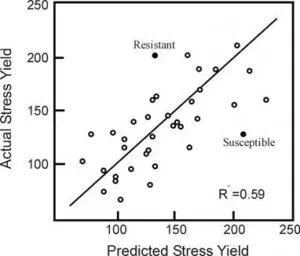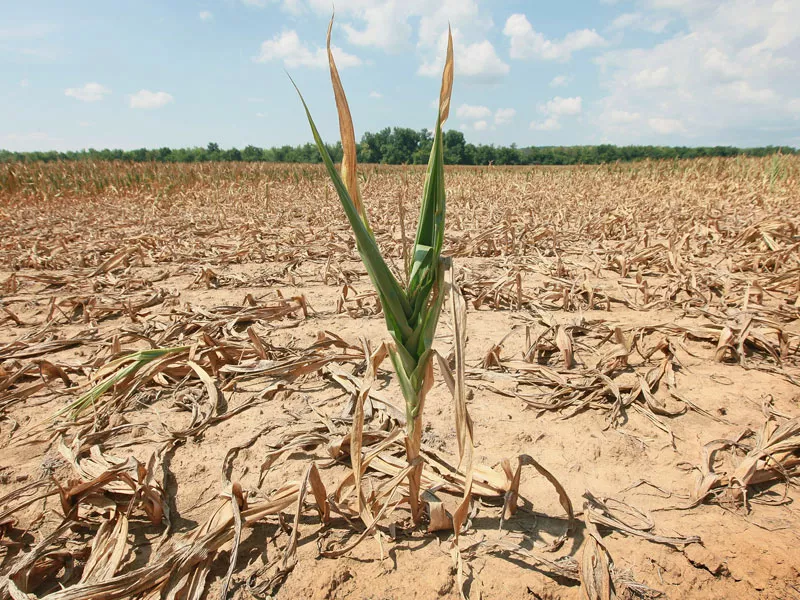evaluating drought resistance in terms of yield – the drought resistance index (dri)
Yield under stress is an important criterion and selection index in breeding for water-limited environments. However, because of the effect of potential yield on yield under stress the latter is not a solid estimate of drought resistance in terms of yield. The rate of yield or biomass reduction by stress (e.g. yield under stress as percent of yield under non-stress) is often used as an estimate of resistance in terms of plant production, in addition to absolute yield under stress. This ratio requires tests under both stress and fully irrigated conditions. Two more accurate estimates of drought resistance in terms of yield were developed and are being used by breeders.
The drought resistance index according to Fisher and Maurer, 1978 *
This index is an improvement over the simple expression of yield under stress as percent of yield under non-stress conditions. Here, DRI is ratio of yield reduction due to stress in a given genotype as compared to the mean reduction over all genotypes in a given test. Originally they proposed a drought susceptibility index. Breeders prefer to use the calculation as a Drought Resistance Index.
DRI = (Ys/Yn)/(Ms/Mn),
Where, Ys and Yn are the genotype yields (or biomass) under stress and non-stress respectively and Ms and Mn are the mean yields (or biomass) over all genotypes in the given test under stress and non-stress respectively.
Sometimes claims were made that this index was not a true representation of drought resistance in terms of yield because it is biased by yield potential (yield under non-stress), namely genotypes of higher yield potential tend to express a lower DRI. This is true, but it is not necessarily a mathematical or a statistical bias. This bias has real biological grounds as discussed by Blum (1995).
The drought resistance index according to Bidinger et al. (1982) **
Yield potential and drought escape (short growth duration) can sustain yield under stress. These are not true drought resistance traits even though they can support yield under stress. There is interest in identifying drought resistance of a cultivar beyond its capacity for potential yield and drought escape. With this analysis the drought (or stress) resistance index (DRI) is identified as variation in grain yield under stress which is not explained by yield potential and drought escape. It is relevant for stress conditions that ascribe an advantage to early flowering, such as terminal stress (stress at final growth stages). Actual yield under stress which is higher than that estimated due to its yield potential or drought escape is an indication of drought resistance.
For this analysis all cultivars must be tested together for yield under stress and non-stress conditions. The procedure for DRI is done first by regressing stress yield on potential (non-stress) yield and drought escape (days to heading measured under non-stress conditions) over all cultivars (“initial regression”). Where this regression is significant, the estimated stress yield for each cultivar by this regression is then calculated. The actual measured yield under stress is then regressed on this estimated yield across all cultivars (“second regression”) (Table 1; Fig. 1). Any cultivar that expresses a positive deviation from this regression line can be defined as drought resistant, independently of the effect of potential yield or growth duration on its yield under stress. This deviation, whether positive (resistant) or negative (susceptible) can be calculated as depicted in Table 1 or it can be calculated by the studentized residuals from the regression for each cultivar, as available in most statistical packages.
Table 1. The regression of actual stress yield on estimated yield (“second regression”) and the calculation of the stress index.

The magnitude of the index indicates the degree of the response. Because the residual includes experimental error as well as specific cultivar by stress interaction (Table 1), most attention should be given to those cultivars with largest indices, typically 1.3 or more.
In the breeding program DRI is considered together with absolute yield under stress and non-stress conditions as well as with other selection criteria such as biotic stress resistance or product quality.

Fig.1. Example of the “second regression” to identify stress resistant and susceptible cultivars.
——————————-
(*) According to:
Fischer, R.A. and R. Maurer, 1978. Drought resistance in spring wheat cultivars. I. Grain yield response. Aust. J. Agric. Res., 29: 897–907.
(**) According to:
Bidinger F.R., Mahalakshmi Y., Talukdar B.S., and Alagarswamy G. 1982. Improvement of drought resistance in pearl millet. In IRRI (Ed) Drought Resistance in Crops with Emphasis on Rice. IRRI, Los Banos, Laguna Philippines. pp. 357-375.








